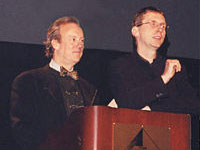The idea that growth can be good is anathema to most environmentalists. Yet that’s exactly the argument made by William McDonough and Michael Braungart in Cradle to Cradle. Take a look at nature, the pair says, and you’ll see that growth is not only good, but necessary — that nature’s very abundance is what environmentalists (and the rest of us) depend on and celebrate. The key is the right kind of growth — and the key to that is better design.

Cradle to Cradle
By William McDonough
and Michael Braungart
North Point Press,
193 pages, 2002
McDonough, an architect, is the founder of McDonough + Partners and has received a slew of awards for his environmental designs. Perhaps most impressive, he was hired by the Ford Motor Company to turn the firm’s original manufacturing plant into a green automobile factory, a $2 billion undertaking. Braungart, a German chemistry Ph.D., cut his teeth leading Greenpeace’s chemical division, then went off to found the German Environmental Protection Encouragement Agency, which helps companies design products with an eye to their entire life cycle.
To understand what that means, take the book itself: The pages of Cradle to Cradle are made of a plastic from which the ink can be easily washed and captured for reuse. The plastic itself can be reused at the same or a higher level, rather than “downcycled,” which is what a lot of recycling really is. (Downcycling is reusing a product at a lower quality level, usually because of degradation or contamination by other materials. Office paper becomes toilet paper, for instance.)
Despite the unusual materials, reading McDonough’s and Braungart’s manifesto will be a familiar experience to environmentalists, because the book, like the larger struggle to preserve the environment, is alternately remarkably encouraging and deeply depressing. Take the authors’ analysis of recycling. Recycling is good, right? In fact, they say, it is often very, very bad. For example, recycling plastic bottles into that groovy fleece jacket means bringing toxic antimony into contact with your skin. Oops. Or how about being more efficient? We know that’s always good, don’t we? Um, actually, no: “Being less bad is not being good,” McDonough told the National Press Club last spring. “If you want to go to Mexico, and you’re driving toward Canada, even if you slow down you’re still going to Canada.”
But just when you’re beginning to despair about environmental solutions, you encounter an idea that makes you sit up in your recycled plastic chair beneath your compact fluorescent light bulb. Take this: “We see a world of abundance, not limits. In the midst of a great deal of talk about reducing the human ecological footprint, we offer a different vision. What if humans design products and systems that celebrate an abundance of human creativity, culture, and productivity? That are so intelligent and safe that our species leaves an ecological footprint to delight in, not lament?”

McDonough and Braungart.
To McDonough’s and Braungart’s credit, much of their book is devoted to explaining how to translate that theory into practice. Their strategy is eminently graspable, for it is based on the straightforward principles that waste is food, that there is no “away,” that everything is part of a cycle. Of course, these are hardly new ideas; indeed, there has been a recent proliferation of voices arguing that a sustainable economy must mimic nature’s ways. What McDonough and Braungart add to that chorus is a cogent argument for designing our way toward that economy.
According to Cradle to Cradle, waste (which is what most pollution is) is a product of bad design. Regulations are enacted to control waste, but the message of regulation is, “Be less bad.” Good design, the authors argue, says, “Be good.” Traditionally, designers of economic processes tried to increase profits and reduce costs. The easiest way to do that was to “externalize” waste as pollution. But as “away” gets closer to home, that becomes less acceptable. Change the game, say McDonough and Braungart, by changing the objectives; don’t seek only to profit financially. Ask yourself, “How can we love all the children, of all species, for all time?”
That’s a little woo-woo, perhaps (and happily, there’s very little of that in this book), but it sums up the paradigm shift proposed by Cradle to Cradle. Impressively, that shift is being implemented in material ways in decidedly non-woo-woo companies such as Herman Miller, Steelcase, Ford, and Nike.
McDonough and Braungart are careful not to be too glib about technical cure-alls, noting that the sort of change they propose is going to be incremental, spurred on by individual commitments to environmentally sound living. Consumers increasingly recognize that the dollars they spend support a whole system, and that they can choose between organic food and factory farms, coal burning plants and wind generation, fair trade and exploited Third World workers. Today, we can learn a lot about the companies behind the items we purchase, and once we know, it’s hard not to make conscious — and conscientious — choices. Companies are starting to grasp this, and Cradle to Cradle is one blueprint for how they, and the rest of us, can profit from that consciousness.
Cradle to Cradle builds on the work of Amory Lovins, who pointed out during the 1970s that people want services like cold beer and hot showers, not raw energy like barrels of oil. Lovins launched an entirely new way of addressing the ongoing energy debate. McDonough and Braungart offer a similar perspective shift. Perversely, their book may lead you to stop recycling your SoBe bottles and start buying virgin printer paper — but it might also drop sustainability issues right onto the CEO’s desk, which is precisely where they need to be.



